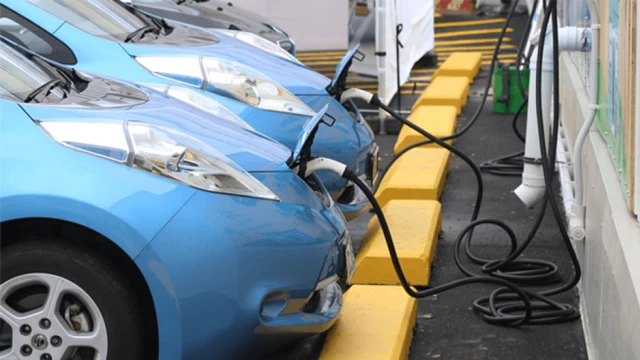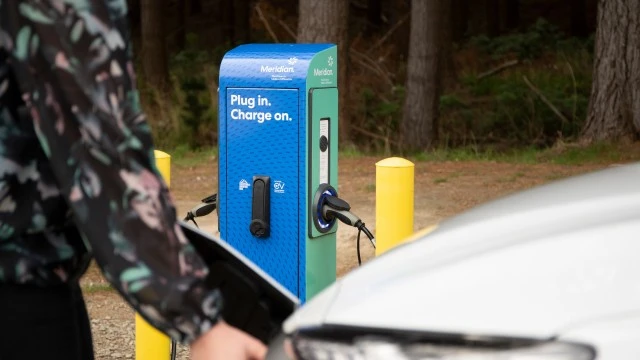Many conversations about electric vehicles will at some point cover batteries. The EV battery is the heart of the vehicle, so it’s important to know what they do, what degrades their health and the costs involved in replacing them. We hope that this guide will give you a head start when shopping around for an EV, or to simply understand your existing electric vehicle better. So let’s ‘charge’ ahead!
The guide to EV batteries

Common terms you’ll hear
There’s plenty of terms around EV batteries that you may come across in your research or during ownership. Here are some of the most common:
- Lithium-Ion – this is a battery technology that’s found in many consumer electronics such as phones, laptops and tablets. It’s also the choice of most modern EVs’ batteries given their lengthy lifespan.
- kWh or kilowatt hours – a unit that represents electrical energy. It is equivalent to consumption of a thousand watts for one hour. In the context of an EV battery, it can be somewhat compared to the size of a fuel tank in a typical vehicle.
- Range – this is a measurement of how far the EV can drive at any given time and is directly proportional to the available battery life. Range is quoted by manufacturers as a maximum but is also an important metric you’ll refer to on your dashboard display.
- SoC or State of Charge – the current level of charge as a percentage – just like your phone.
- Cycle life – how many times a battery can be discharged and charged again before its rated capacity hits a certain level. This is sometimes used to guide owners on when a battery replacement is needed.
- Fast Charge – an EV battery can be charged at different speeds based on the method. While overnight charging at home in the garage will be slower, many public chargers offer fast charging which can top up a car quickly. Bear in mind that too much fast charging can degrade your battery.
- Charge rate – how quickly an EV battery can be charged - measured as kilowatts.
Different types of EV battery chemistry
Batteries in EVs come in several different forms although, as mentioned above, it’s the lithium-ion variant that’s most common. The EV industry is still evolving and with it the science and technologies around battery materials, production methods and performance.
Some other EV battery technologies include nickel-metal hydride, which were found in older models, but they’re heavier than Li-ion batteries.
Lithium-ferrous-phosphate battery technology is emerging in value options, with a cheaper production cost and the added benefits of a long life cycle and lower ‘thermal runway’ risk, meaning potentially safer during damage or short circuits. It may even be safer in more extreme temperatures. A drawback of this chemistry is that lithium ferrous phosphate batteries are heavier than lithium-ion, which impacts range.
Now here’s something really cool: flow batteries. This evolving technology works on a premise of ‘filling up’ your EV as you would an ICE vehicle but, rather than petrol or diesel, it’s a fluid charged with electrolytes. As the fluid is used, it can be replaced at a station with charged liquid in return. Now this isn’t found in EVs or infrastructure yet, but it’s another cool idea among many that will shape the future of electric vehicles.

How EV batteries work
A lithium-ion battery in an electric vehicle has similarities to what’s in your phone or computer and is made up of many small cells that form a battery pack. These cells each store electrical energy, which is supplied through the EV’s charge cable and the power source at home or a charging station.
Charging and discharging an EV battery involves a chemical reaction where lithium ions move between materials in the cell called anodes and cathodes. This releases electrons that power the vehicle or charge up the battery.
What’s unique about the EV battery is the process of ‘regenerative braking’ – as you brake in your EV, the motor generates kinetic energy and sends this charge back into the battery as you reduce speed. Regenerative braking is one of the methods EV manufacturers use to extend the range and battery life of their cars.
The size and demand on an EV battery requires careful thermal management - vehicles have systems to actively manage this to extend the efficiency of the battery and help it perform in different cold or warm conditions.
Why batteries degrade over time
Any battery degrades, and the lithium-ion batteries found in EVs are no different. The chemical reaction in these batteries during charge may lead to changes in the materials, reducing the battery’s capability to retain charge.
Throughout the course of the EV and its battery, it’s likely to have gone through a range of temperatures. Especially cold weather can cause lithium plating on the anode, which impacts battery performance.
The charging frequency and habits is another big factor that impacts the battery’s lifespan. Each time the battery is charged and depleted, that cycle counts towards the battery’s degradation. But the demand on the battery during charge can also play a part - using fast chargers continuously is a good way to wear your EV battery out faster. Opting for slow overnight charges in most cases is a better way to go.
One thing’s for sure, the EV’s battery will degrade and require replacement at some point - if not by you, then a future owner. It’s why Any EV buyer should always take battery into account when weighing up costs.
How to reduce the wear on your battery
A battery is a consumable item. But how quickly you consume really depends on a number of factors. Here’s some ways to lessen the strain on your battery:
- Don't drain your battery to under 20% constantly as it wears on the battery.
- Avoid topping up to full charge every time, instead partially charging to a level that will meet your needs for the day.
- Avoid driving or parking your vehicle in extreme temperatures. Very hot or very cold weather will degrade your battery faster. Your EV may have features to bring the battery to an optimal temperature before charging, which is one example of technology manufacturers use to preserve lifespan.
- Keep your software updated. Car brands will release various updates, some of which relate to the efficiency and management of the battery.
- Drive smoothly and avoid aggressive acceleration or braking that can drain battery life quicker.
- If you’ve got the option of less hilly routes without impacting your time, you’ll save some battery life by not having to put the car on steep inclines as much.
- Charge overnight, slowly as your main method of juicing up - and only use DC fast charging when absolutely necessary.

The environmental impact of battery powered vehicles
While an electric vehicle over its lifespan is much kinder to the environment than combustion engine vehicles, It’s not completely free of issues. Perhaps the most significant is the production of batteries which bring with them manufacturing emissions, reliance on resources like lithium and a concern around appropriate disposal or recycling. Raw materials like lithium and cobalt do have an impact on the natural environment.
These are challenges that are actively being worked on by the industry including the manufacturing processes and ways to recycle and repurpose EV batteries that could power other things once they’re no longer usable for a vehicle.
Replacing your electric vehicle battery – what’s involved
An EV battery will eventually reach the end of its recommended life (usually something a professional EV service provider can determine). Once this happens, you’ll need to replace the battery that powers the vehicle. Before spending the money on replacement, you’ll want to check your car’s warranty - typically the battery is guaranteed for a certain period of time or range.
The car’s app or dash may have useful battery health details that can give you a good indication that it’s time for a replacement.
The replacement will need to be managed by an EV service provider. They’ll order the new battery through the manufacturer or a third party supplier. Once it arrives, the service provider will install the battery. Don’t confuse an EV battery with the small battery that sits under your ICE car’s bonnet - it’s a large unit that requires significant expertise to safely remove and replace. The service provider will run tests to ensure your vehicle and its new battery are fully functional prior to getting on the road.
All things EVs
Thinking of making the switch? We’ve got info on what they cost, why they’re great and heaps more to help you on your journey.
All articles
Owning an electric vehicle in New Zealand
An EV doesn’t just mean different technology, it brings with it different habits than those of a regular car.

Things to look out for with a used EV
In this guide we cover the main parts of a used EV to check – whether that’s at a used car dealer or in a private sale...

Electric Vehicles vs. Petrol or Diesel - Pros and Cons
Let’s talk about some common pros and cons that you might find with EV vs. ICE so you can make an informed decision on...

Comparing different EV options
In this guide, we provide some handy tips that you can refer to when comparing electric vehicles on your shortlist.

Useful information about EV charging at your business
Getting charging infrastructure for your business has many benefits. Here’s some important things to keep in mind.

We’re levelling up the way we do transport
At Meridian, we’re committed to demonstrating our support of low emissions transport on the roads and in our waterways.

Are EVs worth it?
Many people are asking this question when shopping for a new vehicle. In this guide, we'll tackle whether you should...

Choosing an EV for a family
Any car purchase is a big deal, and it takes time to find the right model. Our guide below explores the family car...

How to integrate home solar and an EV
In this guide, we’ll help you get started in your planning to have solar and EV in the home.

Top considerations when buying an EV
Buying an electric vehicle (EV), especially for the first time, is an exciting process. In this guide we explore the...

Considering an EV? The top three considerations for EV charging
When it comes to EV ownership, energy is often the last thing considered. Find out the top considerations for EV...

Charging EVs
Unlike petrol stations, chargers for your EV aren’t quite so common. Don't worry though, you’ve got options.

Plug vs pump – an electric car cost comparison
How much does it cost to buy an EV? And how much does it cost to charge?

Is it worth buying a second-hand Nissan Leaf?
We chatted with Sophie about buying and owning a second-hand Nissan Leaf and how that’s working out for her family.

The top 5 unspoken rules of public EV charging
Don’t be that person… the one who bothers other drivers at public EV charging stations. Lucky for you, we’ve got the...